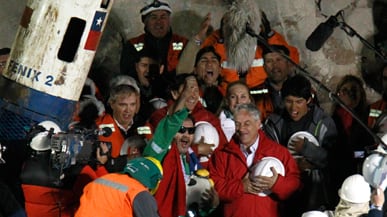We can all rejoice in the successful rescue of the Chilean miners. What’s more, we can all learn some important lessons about how to manage the innovation process in a time of crisis.
First, a word of background. What we need to understand is that Chile has for a number of years been quietly moving with speed and deliberation toward becoming an Innovation Nation. Innovation is a priority for both government and the private sector. Fundacion Chile, a nonprofit established some 34 years ago, has provided strategy and a roadmap for the country’s innovation agenda.
Fiscal prudence has enabled Chile to weather the global financial turmoil and make new investments in such areas as alternative energy and aquaculture. Dynamic and cosmopolitan leadership has given the country a new and inspirational narrative about what is possible. And it should be noted that Chile is one of the world’s most proactive countries in terms of creating international linkages in a wide range of scientific, technical, and innovation-oriented areas. Chilean leaders are constantly to be seen in my hometown of San Francisco, for example, refreshing relationships and exploring collaboration.
Thus it seems to me that this successful rescue is not an accident, but rather reflects a society that has embraced innovation, not just as a value, but also as a practice. There is something valuable to learn here.
What we need to understand is that Chile has for a number of years been quietly moving with speed and deliberation toward becoming an Innovation Nation.

What are the lessons? I’ll present five.
First, a rapid decision to take action at a high level of intensity came from the top. In general, without direction and buy-in, large-scale innovation efforts will not move at the speed or with the focus that is needed. Bottom-up is fine—and in vogue—in terms of innovation diversity, but direction during a crisis is necessary. So this is a story about the kind of leadership that enables mission-driven innovation by taking risks, setting clear goals, and empowering people. The message from the top was clear in Chile: “We are going to do what it takes.”
• 8 Innovations That Saved the Miners• 6 Tales from the MineSecond, this empowerment led to an extraordinary culture of collaboration, surprising even to many insiders, that demonstrated a pragmatic willingness to embrace new rules and roles. Recall that this was at its heart a government-led effort to address a private-sector problem. A coalition formed around an open process that ultimately involved players from around the world. For example, NASA was brought in to work side-by-side with the Chilean navy and a wide range of public- and private-sector experts to generate potential solutions and identify obstacles on the way to success.
Third, the strategy involved developing multiple solution pathways rather than putting all the eggs in one basket. In conditions of uncertainty, all avenues must be explored even at the expense of redundancy and wasted resources. This is something the venture-capital industry understands in swarming an opportunity space; what is remarkable is how that factored into a public-sector response to an unexpected crisis.
Fourth, the government was in control of the story. It managed expectations around the tempo and potential outcome of the rescue in a way that shielded the work process from undue intrusion by media or an overwrought public.
Finally, the desired outcome was defined broadly to ensure success on multiple levels. The goal was not simply to bring 33 people to the surface, but to bring them back in the best possible condition. What we will remember long after the fact of the rescue is the extraordinary humanity with which food, human contact, health and well-being, and information were provided. When you are trapped a half-mile below the surface of the earth, having your favorite strip steak or empanadas, access to the best medical specialists, communications from loved ones, and even video entertainment become a way of maintaining your humanity in a challenged environment. The true measure of Chile’s innovation success is how well the miners looked when they reached the surface.
The benefits for Chile are obvious. One can only imagine how this “we did it” experience will translate into even more of a “can do” spirit for Chile and validate its already considerable investment in an innovation agenda. Marcelo Vasquez from Fundacion Chile told me that “doing it the Chilean way” has taken on a whole new meaning and one hopes that the country will be able to capitalize on this newfound momentum.
What can America and other countries learn from Chile? While the rescue story reflects its particular political and cultural realities, some general principles are evident. First, leadership is key in aggressively setting tempo, creating clear goals, defining the narrative and enabling the kind of collaboration that could otherwise quickly degenerate into squabbling and defensiveness. Being able to facilitate open interaction among diverse parties to generate timely approaches that leave no stone unturned is key to coming up with the best solution.
Deepwater Horizon, anyone?
Dubbed "Mr. Creativity" by The Economist, John Kao is a contributing editor at The Daily Beast and an adviser to both public- and private-sector leaders. He is chairman of the Institute for Large Scale Innovation, whose i20 group is an association of national innovation "czars." He wrote Jamming: The Art and Discipline of Business Creativity, a BusinessWeek bestseller, and Innovation Nation. He is a board adviser to twofour54 and a director of Phylotech, a company that bridges cleantech and life sciences. He is also a Tony-nominated producer of film and stage.





